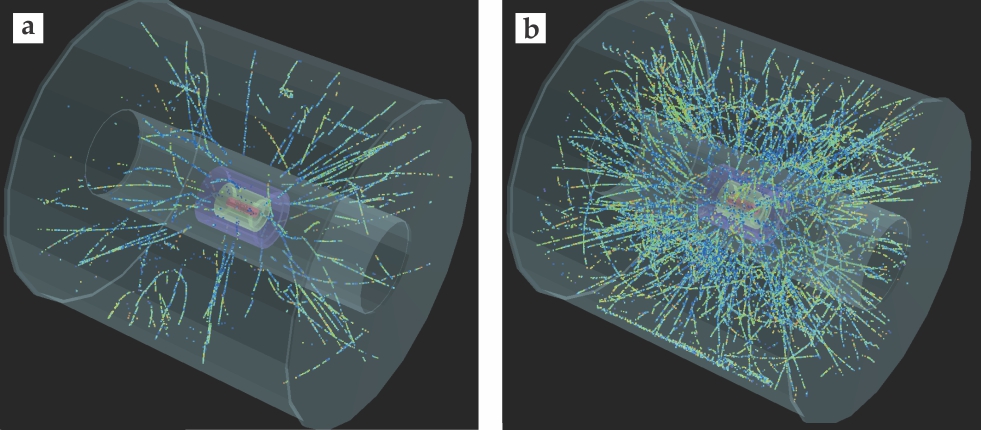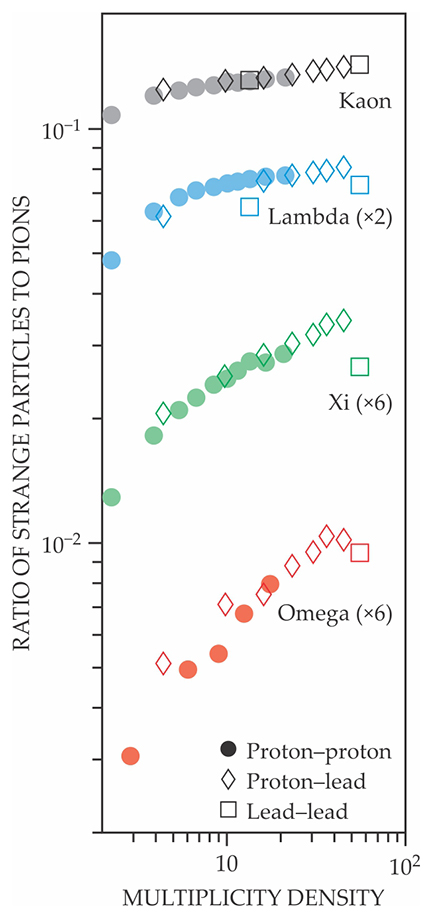Proton–proton collisions prove stranger than expected
DOI: 10.1063/PT.3.3615
By the time the universe was picoseconds old, the four fundamental interactions—strong, weak, electromagnetic, and gravitational—had become distinct from one another. Yet, for another few microseconds, the universe remained too hot to bind quarks into protons, neutrons, and other hadrons. Instead, quarks and gluons, the bosons carrying the strong force, existed as a hot, dense soup called quark–gluon plasma.
More recently, quark–gluon plasma is produced at particle colliders such as CERN’s Large Hadron Collider (LHC) and Brookhaven National Laboratory’s Relativistic Heavy Ion Collider (RHIC) by smashing together the nuclei of heavy atoms. From those collisions, researchers hope to learn about the conditions that were present in the early universe and to probe the nature of strong interactions at high energy densities. Thus far, they have pieced together that quark–gluon plasma behaves as a nearly perfect, viscosity-free fluid. That’s in stark contrast to the electromagnetic plasma, which is best described as a weakly interacting gas of electrons, ions, and photons.
Physicists have thought that quark–gluon plasma could be produced in the lab only through collisions of heavy nuclei. Thus ALICE (A Large Ion Collider Experiment)—a detector built to study quark–gluon plasma—and other detectors at the LHC and at RHIC use proton–proton collisions to obtain a baseline for heavy-ion collisions. Simultaneously colliding many protons and neutrons in close proximity to each other produces quark–gluon plasma, but colliding one pair of protons does not. Or does it?
In the past few years, evidence has been mounting that the creation of quark–gluon plasma may not be the exclusive domain of heavy-ion collisions. For instance, signatures of collective flow indicating a low-viscosity fluid have been detected in both proton–proton and proton–lead collisions at the LHC.
The latest evidence comes from the ALICE collaboration’s analysis of proton–proton collisions measured during the LHC’s first operational run in 2010–13. As shown in figure

Figure 1. When two protons collide inelastically inside the ALICE detector, (a) the typical outcome is a few handfuls of particles. (b) Less than 1% of the time, a collision might produce hundreds of particles. In those rare collisions, the ALICE collaboration found signs that quark–gluon plasma may be forming. (Courtesy of CERN.)

Enhanced production of strange particles in heavy-ion collisions, identified in the 1980s, was one of the first proposed hallmarks of quark–gluon plasma. 2 If it turns out that proton– proton collisions can indeed create quark–gluon plasma, physicists will have found a simpler system than heavy-ion collisions to study the exotic phase of matter.
Squeezing out quarks
According to quantum chromodynamics, the strong interaction displays a property called quark confinement. Because of strong quark–gluon coupling, any attempt to pry loose a quark from a proton or a neutron ends up instead producing new quark–antiquark pairs that immediately bind to other hadrons and resist the quark’s liberation. When hadronic matter is heated and squeezed to conditions resembling those of the early universe, however, the coupling between gluons and quarks starts to weaken. Eventually the hadrons melt into quark–gluon plasma.
Smashing two gold or lead nuclei together at ultrarelativistic speeds creates at the collision point just such conditions, explains particle physicist Wit Busza of MIT. “Then you go to theory and it says, that small blob, which has so much energy density, must be free quarks and gluons.”
In 2000, CERN scientists announced that they had found compelling evidence for quark–gluon plasma in lead–lead collisions. By 2005—after three years of colliding gold nuclei—researchers at RHIC had learned that the newly spotted phase of matter behaved like an inviscid liquid. (For an overview of the RHIC results, see the article by Barbara Jacak and Peter Steinberg, Physics Today, May 2010, page 39
Two of the signatures discovered at RHIC have come to take center stage in studies of quark–gluon plasma: so-called jet quenching and collective hydrodynamic flow. High-energy collisions tend to produce multiple particles that fly out in common directions as collimated jets. Jet quenching occurs because those particle jets lose much of their energy as they traverse quark–gluon plasma. The collective flow indicates a thermalized, zero-viscosity liquid-like state.
In 2010 the LHC began slamming protons into each other at an energy an order-of-magnitude higher than what’s possible at RHIC. Just months into the first operational run, the CMS (Compact Muon Solenoid) collaboration found that the debris of high-multiplicity proton–proton collisions also displayed spatial correlations indicative of collective flow. 3
“Before, we thought you could only make quark–gluon plasma in heavy-ion collisions,” says Yale University’s Helen Caines, a cospokesperson for RHIC’s STAR (Solenoidal Tracker at RHIC) collaboration and a member of the ALICE collaboration. That the assumption may not hold doesn’t rock the foundations of quantum chromodynamics, but it does show that phenomenological models that apply the theory to particle collisions may need revamping.
By 2013 two other LHC experiments—ALICE and ATLAS (A Toroidal LHC Apparatus)—had measured similar signs of collective liquid-like behavior in proton–lead collisions. 4 In addition, the ALICE collaboration reported last year that high multiplicity also enhances strangeness production in proton–lead collisions. 5
The ALICE collaboration’s finding of strangeness enhancement in proton–proton collisions is another indication that heavy-ion collisions may not be the only way to make quark–gluon plasma. Figure

Figure 2. As more and more particles are produced in proton–proton collisions—given by a unitless quantity called multiplicity density—the ratio of strange particles to pions increases. The effect is stronger for particles with more strange quarks: A kaon contains two quarks, one of them strange; a lambda contains one strange quark out of three; a xi has two strange quarks out of three; and an omega contains three strange quarks. Numbers in parentheses are scaling factors. (Adapted from ref.

However, Busza warns against reading too much into that comparison. He notes that in lead–lead collisions, multiplicity density is mostly a measure of how many constituent protons and neutrons collide, whereas in proton–proton collisions, it is more a proxy of how violent each proton–proton collision is. As suggestive as the new finding is, he says, he would have been more convinced if the strangeness enhancement came to a plateau. Such a plateau would suggest a transition from hadronic matter to quark–gluon plasma.
“Quark–gluon plasma would provide a ready-made explanation for what we observe,” explains ALICE spokesperson Federico Antinori, “but there are still many open points.” For example, what happens at even higher multiplicities? With the LHC well into its second operational run, Antinori says, “Our plan is to really have a comprehensive measurement of the physics of high-multiplicity proton–proton collisions.”
Those complete measurements also include looking for signs of jet quenching, which has yet to be conclusively detected in proton–proton or proton–lead collisions. “That would be our killer measurement,” says Caines, but she adds that it’s trickier than it sounds. Jet quenching in heavy-ion collisions is identified by comparing the energies of particles produced in them with the energies of particles produced in proton–proton collisions. At the moment, no such baseline exists for proton–proton collisions.
Caines also notes, “It’s not like finding the Higgs where you say, oh look, there’s the peak.” As happened with heavy-ion collisions, it will be a collective body of evidence that solves the riddles of whether quark–gluon plasma can be created with proton–proton collisions.
References
1. J. Adam et al. (ALICE collaboration), Nat. Phys. 13, 535 (2017). https://doi.org/10.1038/nphys4111
2. P. Koch, B. Müller, J. Rafelski, Phys. Rep. 142, 167 (1986). https://doi.org/10.1016/0370-1573(86)90096-7
3. V. Khachatryan et al. (CMS collaboration), J. High Energy Phys. 2010(9), 91 (2010). https://doi.org/10.1007/JHEP09(2010)091
4. G. Aad et al. (ATLAS collaboration), Phys. Rev. Lett. 110, 182302 (2013); https://doi.org/10.1103/PhysRevLett.110.182302
B. Abelev et al. (ALICE collaboration), Phys. Lett. B 719, 29 (2013). https://doi.org/10.1016/j.physletb.2013.01.0125. J. Adam et al. (ALICE collaboration), Phys. Lett. B 758, 389 (2016). https://doi.org/10.1016/j.physletb.2016.05.027
